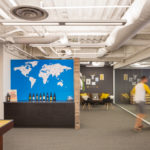Rethinking Workspace in the Age of Innovation
By Jason Hughes
Tech companies have influenced our lives tremendously in the last decade. Think Google. Uber. Facebook. Apple. They’ve also had an enormous influence in the past 10 years or so on office design. (Beginning with a love for bare brick walls and exposed duct ceilings.)
Companies like Facebook, Apple, and Google have been applauded for their workspaces with open concept office floorplans, numerous cafeterias, on-site massages, and exercise rooms. Indeed, Google’s goal is “to create the happiest, most productive workplace in the world.” But while these floorplans appear in all of the “coolest offices” articles in Fast Company and the New York Times, we really have to ask a couple of questions:
Are employees happier?
Are they more productive?
The Reality of Open Floorplans
Many companies have recently embraced open floor plans, my clients included. By turning their backs on the boring, vanilla cubicle layouts of times past, open spaces instantly convey that an organization is progressive and forward thinking. Accounting departments are also big on open floorplans because less square footage is required. In fact, today’s office worker averages 175 square feet of space—down from 225 square feet in 2010, and 275 square feet in 2007.
Open spaces create a more casual environment that ignites creativity and promotes camaraderie among employees. Teammates can just ask a question across the room to get an answer from a co-worker. Meetings aren’t always planned but happen spur of the moment as teams gather around a screen. Open floor plans also have another advantage — they can accommodate additional growth easier than a traditional floorplan with private offices.
But there’s a downside to the increased conversation — a drop in concentration and productivity. As required square footage per employee has plummeted, so has long-term morale. With additional interruptions, it is harder to get work done. In fact, research tells us that after an interruption, it can take up to 23 minutes for an employee to get back to the original task. (And most likely an employee is likely to be interrupted again before that 23 minutes is up.)
Open spaces have also created their own modern day office etiquette. If someone is wearing headphones, it is often the equivalent of a closed office door that communicates, “I’m trying to get some work done.”
What’s Needed to Make Open Floorplans Successful
The problem is companies often look to the economic advantages of the open floor plan without looking at the rest of the equation. Yes, Google has open plan offices, but they are also very, very generous with perks, amenities, and common areas.
The advice I give to my clients is that if you choose an open office plan, you also need to budget for the communal areas, amenities, and smaller private spaces that contribute to company culture – or brace yourself for a drop-off in productivity. Be prepared to dedicate up to 15% of your square footage to these spaces. These common areas encourage the serendipitous moments that contribute to cross-departmental conversations, while helping employees stay engaged and be productive.
- Lounges. Offer your employees places where they can get away from their desks and still get work done.
- Common thinking areas. Create common areas or breakout rooms with white boards where teams can hash out their ideas on an impromptu basis.
- Private workspaces. Be generous with offering private areas where employees can work uninterrupted in silence in order to meet deadlines or make private calls. This is often what employees in open space environments crave the most.
- Recreation areas. Yes, foosball tables are almost a cliché, but giving your employees a place to blow off steam makes the workday more enjoyable and helps build friendships.
Do What Works for Your Company Culture
Take time to thoughtfully plan a space that will enhance the culture of your organization.
Our headquarters at Hughes Marino offer numerous private offices, some shared offices, and a small open work area, along with plenty of communal space. We have a spacious living room with large, comfy sofas on the first floor, a communal kitchen where employees share lunch, multiple conference rooms for collaborating, a fully equipped gym, and a game room. (Yes, we even have a putting green.) This hybrid approach offers all the best aspects of an open plan space, while still ensuring that everyone gets the privacy they need to concentrate and focus on their work.
If you’re thinking of renewing, expanding, contracting, or relocating to new office space, be sure to give Hughes Marino a call and we can help you make the most of your existing space or help you find a new location.
This article first appeared in CSQ Magazine.
Jason Hughes is founder of Hughes Marino, an award-winning commercial real estate company with offices across the nation. A pioneer in the field of tenant representation, Jason has exclusively represented tenants and buyers for more than 30 years. Contact Jason at 1-844-662-6635 or jason@hughesmarino.com to learn more.











